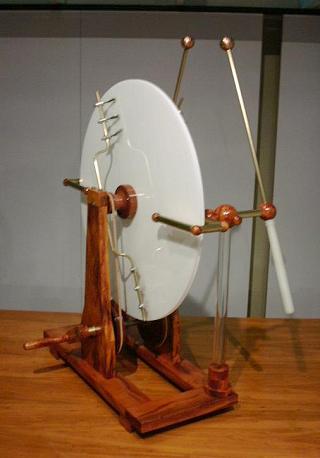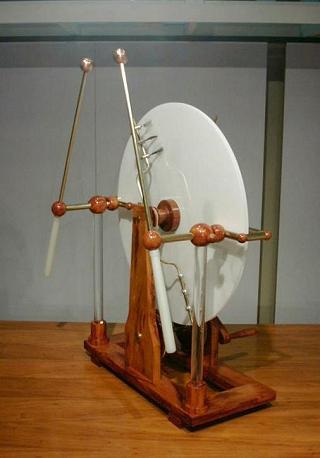A Bonetti machine with
original ebonite disks
 Along with the old Radiguet &
Massiot multiple Bonetti machine that my university received
as donation in 1999, come three extra ebonite disks, with 54 cm
(21.25") of diameter and 3.2 mm (1/8") of thickness.
These disks had marks of use in some old Bonetti machine, and
were identical to four disks that were adapted to the restored
machine, replacing the original, broken, disks, that come also
along with it. By December 1999 I decided to make another machine
using the best two of these disks.
Along with the old Radiguet &
Massiot multiple Bonetti machine that my university received
as donation in 1999, come three extra ebonite disks, with 54 cm
(21.25") of diameter and 3.2 mm (1/8") of thickness.
These disks had marks of use in some old Bonetti machine, and
were identical to four disks that were adapted to the restored
machine, replacing the original, broken, disks, that come also
along with it. By December 1999 I decided to make another machine
using the best two of these disks.
The electrostatic influence machine known as the Bonetti machine is a sectorless Wimshurst machine, invented by Bonetti,
a French instrument builder, in 1894.
I made a solid structure with classic lines using hard wood (a
nice pink wood named here "peroba rosa"), composed of
four bars as the base, joined by screws at the wood blocks that
make the four feet, with two upright supports fixed to the base
by screws. I made the two axles from the polished steel guide bar
or a discarded printer, cut in two parts, one with 20 cm and
another with 25 cm. The disks and these axles determined the size
of the machine. I turned the two bosses
for the disks in my lathe, and put brass tubes at their centers,
to make then turn over the upper axle. Ball bearings would be
better, but I wanted to make a machine closer to old designs.
With good lubrication, the simple tube bearings work well. The
upper axle was fixed to the uprights by wood blocks screwed to
the uprights, contributing to the solidity of the structure,
essential in a machine of this size. The lower axle turns on
turned bronze bearings that cross the
uprights, and is moved by a wooden crank,
that I made with a handle that can rotate. The lower pulleys are
also made of wood. The pulleys and the crank are glued to similar
turned bronze centers, that are fixed to the lower axle by the
pressure of set screws. Round leather cords closed by steel wire
clamps interconnect the lower pulleys to the pulleys in the
bosses, one straight and the other crossed, to make the disks
turn in opposite directions.
The neutralizers are sets of three
brushes, also borrowed from the materials that come with the
R. & M. machine.They are made of many thin silver (?) strips.
I mounted the brushes in aluminum cylinders (balls would look
better), that can be positioned over the length of brass bars.
The brass bars are screwed in bronze rings, that are fixed to the
upper axle by brass set screws, adjacent to the bosses that hold
the disks. The brushes are positioned so they sweep the disks,
touching them lightly only. This configuration is very
convenient, as I can adjust the position and the number of
brushes, and set the neutralizers at any angle.
The charge collectors and terminals
are rather complicated assemblies of brass tubes and turned wood
balls, inspired in the charge collectors of a large Wimshurst machine, with copper
blades facing the disks for charge collection. The tubes and
balls that make the square charge collectors
are fixed by threaded rods inside the tubes, that screw into the
wood balls. The tubes touch at the corners, or are close enough,
to make sufficiently good electrical connections. The copper
blades are simply fixed by the pressure of the balls at the ends
of the tubes. The charge collectors are fixed to the main
conductors by screws inside the conductors, with the joint
covered by a rounded wood piece. The conductors pass through
large wood balls supported by long insulators, and are fixed in
position by screws made of sections of threaded rod and wood
balls. The terminals have turned handles made of nylon, and are
fixed to the main conductors by wood balls with bronze plugs
inserted in the conductor tubes, so they can be rotated. Internal
springs improve the connection between the terminal tubes and the
plugs. The insulators are made of acrylic (I couldn't find glass
bars, and anyway acrylic is more effective) and end on copper
balls made by metal spinning.
To make the old disks usable again I had to polish them,
removing the decayed brown material covering the ebonite. This
material forms with time and exposure to light, and its
conductivity turns the disks practically unusable. I would prefer
to leave the old disks as they were, just cleaning them as I did
with the R. & M. machine, but the machine refused to work
with them. Fortunately, the decay was only superficial, and
little material had to be removed. I used #600 and #1500 wet
sandpaper, and finished with a polishing compound. The disks were
also a bit warped, but I could mount them with sufficient
precision in the bosses, using three flat head screws in the
existing holes in the disks, with the heads pressing against 2 mm
round aluminum plates from the inner side. The disks run
separated by a fiber washer at the center of the upper axle.
The wood parts were finished with four layers of polyurethane
varnish, sanding between the applications. The metal parts were
lacquered with shellac varnish, heated in an alcohol flame before
and after the application of the varnish. The disks were
protected with a furniture maintenance product based on carnauba
wax and silicone.
The result was a machine with classic appearance, but with
some modern materials, as acrylic and nylon in the insulators.
The use of wood in the charge collectors is also uncommon in
classic machines, but the ideal material, cast hollow brass
balls, was impossible to obtain. Turned solid metal balls would
be rather heavy and difficult to make, and spun balls too
fragile. The wood works perfectly well there.
The machine is easily excited using another machine to spray
some charge at a position opposite to one of the neutralizers,
while the machine is stopped. After this, a few turns of the
crank get it highly excited, and it keeps enough charge in the
disks for immediate startup for some time (depends on humidity)
if stopped. This relatively easy excitation is and interesting
consequence of the use of brushes instead of the combs that I
used in my other Bonetti machine.
Working, it produces sparks with up to
20 cm, with or without Leyden jars. I have yet to make Leyden
jars suitable for this machine, as all my jars spark over when
the spark length exceed about 16 cm. To obtain 20 cm sparks with
Leyden jars, I had to cascade two jars at each terminal, and use
terminal balls with 3.7 cm of diameter. With smaller balls (3.3
cm, as seen in the pictures) it doesn't exceed 19 cm. With larger
balls and drier air (tests made at 75% of humidity), possibly
longer sparks could be obtained, as the clearances in the
structure allow up to 24 cm, and there is intense corona in the
terminal balls after the spark limit.
Views of the machine: Front, back, side, other side.
Modifications:


By April 2002, I decided to reform the machine to solve some
problems that it was presenting. The tube bearings in the disk
bosses were not tight enough, and so I removed them, replacing
the tubes by precise nylon bushings inserted at the ends of the
wood bosses. I reformed the charge collectors, fixing the copper
blades to the tubes with brass screws. And finally, the old disks
were never satisfatory, being somewhat warped, and worse, having
a terrible smell and liberating a corrosive substance that was
attacking the metal parts and turning the disks conductive. Due
to the corrosion, I had to redo the lacquering of the brass
parts, this time applying three layers of filtered shellac. I
returned the old disks to their retirement, and made new disks in
acrylic, using 3 mm white acrylic plates that I had, reserved for
a big machine. The modified machine works very well. Once charged
by spray from a terminal of other machine in front of one of the
neutralizers, it keeps charge for hours. It produces much more
current than with the old disks (theoretically 45 ľA for 2 turns
per second in the crank), and produces frequent sparks with up to
20 cm, still with cascaded Leyden jars
and its normal copper terminal balls. I made new Leyden jars with 82 pF for it and
obtained beautiful powerful sparks with
them.
Created: 4 February 2000
Last update: 29 July 2002
Antonio Carlos M. de Queiroz
http://www.coe.ufrj.br/~acmq
Return to Electrostatic Machines
 Along with the old Radiguet &
Massiot multiple Bonetti machine that my university received
as donation in 1999, come three extra ebonite disks, with 54 cm
(21.25") of diameter and 3.2 mm (1/8") of thickness.
These disks had marks of use in some old Bonetti machine, and
were identical to four disks that were adapted to the restored
machine, replacing the original, broken, disks, that come also
along with it. By December 1999 I decided to make another machine
using the best two of these disks.
Along with the old Radiguet &
Massiot multiple Bonetti machine that my university received
as donation in 1999, come three extra ebonite disks, with 54 cm
(21.25") of diameter and 3.2 mm (1/8") of thickness.
These disks had marks of use in some old Bonetti machine, and
were identical to four disks that were adapted to the restored
machine, replacing the original, broken, disks, that come also
along with it. By December 1999 I decided to make another machine
using the best two of these disks. 
